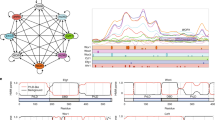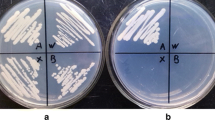Abstract
The phase transition between the white and opaque phenotypes in the switching system of Candida albicans strain WO-1 is accompanied by the differential expression of the white-specific gene WH11 and the opaque-specific gene PEP1. The frequency of integrative transformation at the white-specific gene locus WH11 is between 4.5 and 7.0 times more frequent in white than in opaque spheroplasts, and the frequency of disruptive transformation at the opaque-specific gene locus PEP1 is 30.5 times more frequent in opaque spheroplasts than in white spheroplasts. In contrast, the frequencies of integrative transformation at the constitutively expressed loci ADE2 and EF1α2 are similar in the white and opaque phases. Therefore, the frequency of integration of linear plasmid DNA containing sequences of phase-specific genes correlates with the transcriptional state of the targeted locus.
Similar content being viewed by others
References
Anderson JM, Soll DR (1987) Unique phenotype of opaque cells in the white-opaque transition of Candida albicans. J Bacteriol 169:5579–5588
Anderson JM, Cundiff L, Schnars B, Gao M, Mackenzie I, Soll DR (1989) Hypha formation in the white-opaque transitions of Candida albicans. Infect Immun 57:458–467
Anderson JM, Mihalik R, Soll DR (1990) Ultrastructure and antigenicity of the unique cell and pimple of the Candida opaque phenotype. J Bacteriol 172: 224–235
Bedell GW, Soll DR (1979) Effects of low concentrations of zinc on the growth and dimorphism of Candida albicans: evidence for zinc-resistant and -sensitive pathways for mycelium formation. Infect Immun 26: 348–354
Berg DE, Howe MM (eds) (1989) Mobile DNA. American Society for Microbiology, Washington, D.C., USA
Bergen M, Voss E, Soll DR (1990) Switching frequencies for the white-opaque transition. J Gen Microbiol 136:1925–1936
Blackwell TK, Moore MW, Yancopoulos GD, Suh H, Lutzker S, Selsing E, Alt FW (1986) Recombination between immunoglobin variable region gene segments is enhanced by transcription. Nature 324:585–589
Cannon DR, Jenkinson HF, Sheperd MG (1990) Isolation and nucleotide sequence of an autonomously replicating sequence (ARS) element functional in Candida albicans and Saccharomyces cerevisiae. Mol Gen Genet 221:210–218
Fonzi AW, Irvin YM (1993) Isogenic strain construction and gene mapping in Candida albicans. Genetics 134:717–728
Gorman JA, Chan W, Gorman JW (1991) Repeated use of GALI for gene disruption in Canadida albicans. Genetics 129:19–24
Hube B, Turner CJ, Odds FC, Eiffert H, Boulnois GJ, Kochel H, Ruchel R (1991) Sequence of the Canadida albicans gene encoding the secretory aspartate proteinase. J Med Vet Mycol 29:129–132
Kennedy MJ, Rogers AL, Hanselman LR, Soll DR, Yancey RJ (1988) Variation in adhesion and cell surface hydrophobicity in Candida albicans white and opaque phenotypes. Mycopathologia 102:149–156
Klar AJS, Strathern JN, Hicks JB (1981) A position-effect control for gene transposition: state of expression of yeast mating-type genes affects their ability to switch. Cell 25: 517–524
Kurtz MB, Marrinan J (1989) Isolation of Hem3 mutants from Candida albicans by sequential gene disruption. Mol Gen Genet 217:47–52
Kurtz MB, Cortelyou MW, Kirsch DR (1986) Integrative transformation of Canadida albicans using a cloned Candida ADE2 gene. Mol Cell Biol 6:142–149
Lee KL, Buckley HR, Campbell CC (1975) An amino acid liquid synthetic medium for development of mycelial and yeast forms of Candida albicans. Sabouraudia 13:148–153
Mansour SL, Thomas KR, Capecchi MR (1988) Disruption of the proto-oncogene int-2 in mouse embryo-derived stem cells: a general strategy for targeting mutations to non-selectable genes. Nature 336:348–352
Morrow B, Srikantha T, Soll DR (1992) Transcription of the gene for a pepsinogen, PEP1, is regulated by white-opaque switching in Candida albicans. Mol Cell Biol 12:2997–3005
Morrow B, Srikantha T, Anderson J, Soll DR (1993) Coordinate regulation of two opaque-specific genes during white-opaque switching in Candida albicans. Infect Immun 61:1823–1828
Nasmyth K (1982) The regulation of yeast mating-type chromatin structure by SIR: and action at a distance affecting both transcription and transposition. Cell 30: 567–578
Pomes R, Gil C, Nombela C (1985) Genetic analysis of Candida albicans morphological mutants. J Gen Microbiol 131: 2107–2113
Rikkerink EH, Magee BB, Magee PT (1988) Opaque-white phenotypic transition: a programmed morphological transition in Candida albicans. J Bacteriol 170: 895–899
Sanger F, Nicklen S, Coulson AR (1977) DNA sequencing with chain-termination inhibitors. Proc Nate Acad Sci USA 74:5463–5467
Shapiro JA (1983) Mobile genetic elements. Academic Press, Orlando, Florida
Sherman F, Fink GF, Hicks JB (1986) Laboratory course manual for methods in yeast genetics. Cold Spring Harbor Laboratory Press, Cold Spring Harbor, New York pp 117–119
Slutsky B, Buffo J, Soll DR (1985) High frequency switching of colony morphology in Candida albicans. Science 230: 666–669
Slutsky B, Stabell M, Anderson J, Risen L, Pfaller M, Soll DR (1987) White-opaque transition: a second high frequency switching system in Canadida albicans. J Bacteriol 169:189–197
Soll DR (1990) Dimorphism and high frequency switching in Candida albicans. In: Kirsch DR, Kelly R, Kurtz MB (eds) The genetics of Candida. CRC Press, Boca Raton, Florida, pp 147–176
Soll DR (1992) High frequency switching in Candida albicans. Clin Microbiol Rev 5:183–203
Soll DR, Anderson J, Bergen M (1991) The developmental biology of the white-opaque transition in Canadida albicans. In: Prasad R (ed) The molecular biology of Candida albicans. Springer-Verlag, Berlin, pp 20–45
Soll DR, Morrow B, Srikantha T (1992) Switching and gene regulation in Candida albicans. In: Broda PMA, Oliver SG, Sims PFG (eds) In: The eukaryotic microbial genome. Oxford University Press, Oxford, pp 211–240
Soll DR, Morrow B, Srikantha T (1993) High frequency switching in Candida albicans. Trends Genet 9:61–65
Srikantha T, Soil DR (1993) A white-specific gene in the white-opaque switching system of Candida albicans. Gene 131: 53–60
Stone RL, Matarese V, Magee BB, Magee PT, Bernlohr DA (1990) Cloning, sequencing and chromosomal assignment of a gene from Saccharomyces cerevisiae which is negatively regulated by glucose and positively by lipids. Gene 96:171–176
Sundstrom P, Smith D, Sypherd PS (1990) Sequence analysis, and expression of the two genes for elongation factor 1α from the dimorphic yeast Candida albicans. 172:2036–2045
Thomas JB, Rothstein R (1989) Elevated recombination rates in transcriptionally active DNA. Cell 56:619–630
Vargas K, Wertz PW, Drake D, Morrow B, Soll DR (1994) The differential effects of keratinized and nonkeratinized epithelium on adhesion and hypha induction of the switch phenotype of Candida albicans strain 3153A. Infect Immun 62:1328–1335
Voelkel-Meiman K, Keil RL, Roeder GS (1987) Recombination-stimulating sequences in yeast ribosomal DNA correspond to sequence regulating transcription by RNA polymerase I. Cell 48:1071–1079
White TC, Miyasaki SH, Agabian N (1993) Three distinct secreted aspartyl proteinases in Candida albicans. Bacteriology 175: 6126–6133
Author information
Authors and Affiliations
Additional information
Communicated by W. Goebel
Rights and permissions
About this article
Cite this article
Srikantha, T., Morrow, B., Schröppel, K. et al. The frequency of integrative transformation at phase-specific genes of Candida albicans correlates with their transcriptional state. Molec. Gen. Genet. 246, 342–352 (1995). https://doi.org/10.1007/BF00288607
Received:
Accepted:
Issue Date:
DOI: https://doi.org/10.1007/BF00288607




